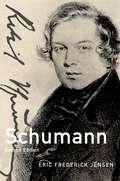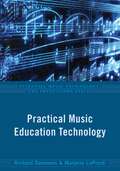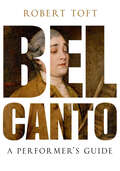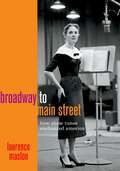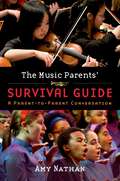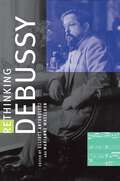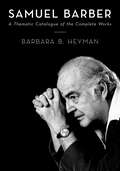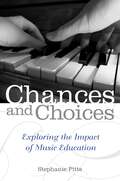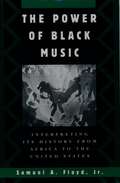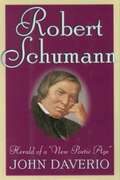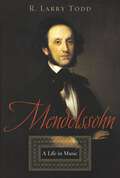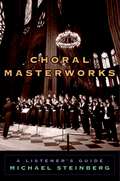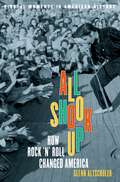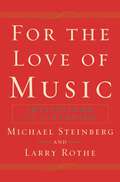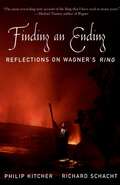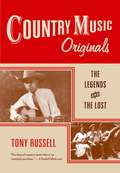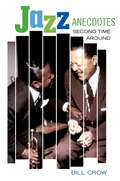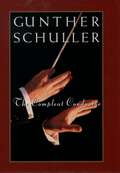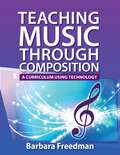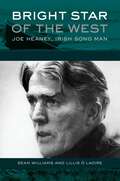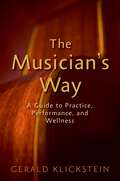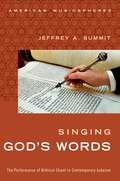- Table View
- List View
Schumann (Master Musicians Series)
by Eric Frederick JensenRobert Schumann is one of the most intriguing-and enigmatic-composers of the nineteenth century. Extraordinarily gifted in both music and literature, many of his compositions were inspired by poetry and novels. For much of his life he was better known as a music critic than as a composer. But whether writing as critic or composer, what he produced was created by him as a reflection of his often turbulent life. Best known was the tempestuous courtship of his future wife, the pianist Clara Wieck. Though marriage and family life seemed to provide a sense of constancy, he increasingly experienced periods of depression and instability. Mounting criticism of his performance as music director at Dusseldorf led to his attempted suicide in 1854. Schumann was voluntarily committed to an insane asylum near Bonn where, despite indications of improvement and dissatisfaction with his treatment, he spent the final two years of his life. Drawing on original research and newly published letters and journals from the time, author Eric Frederick Jensen presents a balanced portrait of the composer with both scholarly authority and engaging clarity. Biographical chapters alternate with discussion of Schumann's piano, chamber, choral, symphonic, and operatic works, demonstrating how the circumstances of his life helped shape the music he wrote. Chronicling the romance of Robert and Clara, Jensen offers a nuanced look at the evolution of their relationship, one that changed dramatically after marriage. He also follows Schumann's creative musical criticism, which championed the burgeoning careers of Chopin, Liszt, and Brahms and challenged the musical tastes of Europe.
Practical Music Education Technology (Essential Music Technology:The Prestissimo Series)
by Richard Dammers Marjorie LoPrestiToday's music teachers are caught in a conundrum about technology - while all are interested in it and told to utilize it in music instruction, a lack of equipment and funding act as enormous barriers to technology access. In fact, studies indicate that the mere perception of these obstacles may be partly responsible for the gap between these teachers' interest in technology and the lack of technology integration in the classroom. As a result, students potentially miss out on active, hands-on music technology instruction at school. In Practical Music Education Technology, veteran music educators Rick Dammers and Marjorie LoPresti help music teachers introduce technology into the classroom by providing accessible strategies to support and enrich students' musical learning. The authors highlight a plethora of free online tools at teachers' disposal, and provide options that can be flexible for all school environments and types of teachers - from those with large budgets to those operating on a shoestring, from those well-versed in technology to non-experts. Each chapter outlines pedagogically appropriate resources and strategies that facilitate, support, and enhance music learning, performance, and creation. Additionally, model lesson plans featuring classroom-tested uses of technology aim to empower student engagement while also keeping music learning goals at the forefront. All teaching ideas presented can be tailored to individual teachers' needs and preferences, making Practical Music Education Technology an essential guide to music technology for the everyday music teacher.
Bel Canto: A Performer's Guide
by Robert ToftBel canto, or 'beautiful singing,' remains one of the most elusive performance styles vocalists strive to master. During the eighteenth and early nineteenth centuries, composers routinely left the final shaping of recitatives, arias, and songs to performers, and singers treated scores freely so that inexpressively notated music could be turned into passionate declamation. In other words, vocalists saw their role more as one of re-creation than of simple interpretation. Familiarity with the range of strategies prominent singers of the past employed to unlock the eloquent expression hidden in scores enables modern performers to take a similar re-creative approach to enhancing the texts before them. In this first ever guide to bel canto, author Robert Toft provides singers with the tools they need not only to complete the creative process the composer began but also to bring scores to life in an historically-informed manner. Replete with illustrations based on excerpts from Italianate recitatives and arias by composers ranging from Handel to Rossini, the book offers discussions of the fundamental principles of expressive singing, each section including a practical application of the techniques involved. Drawing on a wealth of documents from the era, including treatises, scores, newspaper reviews, and letters, this book captures the breadth of practices singers used in the bel canto period. Complete with six scores (recitatives and/or arias) for performers to personalize through the old methods, and a companion website offering demonstrations of the principles involved, Bel Canto is an essential resource for any singer or vocal instructor wishing to explore and master historical techniques of interpretation and re-creation from the eighteenth and early nineteenth centuries.
Broadway to Main Street: How Show Tunes Enchanted America
by Laurence MaslonThe music of Broadway is one of America's most unique and popular calling cards. In Broadway to Main Street: How Show Tunes Enchanted America, author Laurence Maslon tells the story of how the most beloved songs of the American Musical Theater made their way from the Theater District to living rooms across the country. The crossroads where the music of Broadway meets popular culture is an expansive and pervasive juncture throughout most of the twentieth century--from sheet music to radio broadcasts to popular and original cast recordings--and continues to influence culture today through television, streaming, and the Internet. The original Broadway cast album--from the 78 rpm recording of Oklahoma! to the digital download of Hamilton--is one of the most successful, yet undervalued, genres in the history of popular recording. The challenge of capturing musical narrative with limited technology inspired the imagination of both the recording industry and millions of listeners: between 1949 and 1969, fifteen different original cast albums hit number one on the popular music charts, ultimately tallying more weeks at number one than all of the albums by Frank Sinatra, Elvis Presley, and The Beatles combined. The history of Broadway music is also the history of American popular music; the technological, commercial, and marketing forces of communications and media over the last century were inextricably bound up in the enterprise of bringing the musical gems of New York's Theater District to living rooms along Main Streets across the nation. Featuring new interviews with Stephen Schwartz, Chita Rivera, Steve Lawrence, and prominent record producers and music critics, the story of this commercial and emotional phenomenon is told here in full--from the imprimatur of sheet music from Broadway in the early 20th century to the renaissance of Broadway music in the digital age, folding in the immense impact of show music on American culture and in the context of the recording industry, popular tastes, and our shared national identity. A book which connects cherished cultural artifacts to the emotional narratives at the core of American popular music, Broadway to Main Street: How Show Tunes Enchanted America is an ideal companion for all fans of American musical theater and popular music.
The Music Parents' Survival Guide: A Parent-to-Parent Conversation
by Amy NathanThis book of parent-to-parent advice aims to encourage, support, and bolster the morale of one of music's most important back-up sections: music parents. Within these pages, more than 150 veteran music parents contribute their experiences, reflections, warnings, and helpful suggestions for how to walk the music-parenting tightrope: how to be supportive but not overbearing, and how to encourage excellence without becoming bogged down in frustration. Among those offering advice are the parents of several top musicians, including the mother of violinist Joshua Bell, the father of trumpeter Wynton Marsalis, the parents of cellist Alisa Weilerstein, and those of violinist Anne Akiko Meyers. The book also features advice from music educators and more than forty professional musicians, including Paula Robison, Sarah Chang, Anthony McGill, Jennifer Koh, Jonathan Biss, Toyin Spellman-Diaz, Marin Alsop, Christian McBride, Miguel Zenón, Stephanie Blythe, Lawrence Brownlee, Kelli O'Hara, as well as Joshua Bell, Alisa Weilerstein, Wynton Marsalis, Anne Akiko Meyers, and others. The topics they discuss span a wide range of issues faced by the parents of both instrumentalists and singers, from how to get started and encourage effective practice habits, to how to weather the rough spots, cope with the cost of music training, deal with college and career concerns, and help young musicians discover the role that music can play in their lives. The parents who speak here reach a unanimous and overwhelming conclusion that music parenting is well worth the effort, and the experiences that come with it - from sitting in on early lessons and watching their kids perform onstage to tagging along at music conventions as their youngsters try out instruments at exhibitors' booths - enrich family life with a unique joy in music.
Rethinking Debussy
by Elliott Antokoletz Marianne WheeldonComposer, pianist, and critic Claude Debussy's musical aesthetic represents the single most powerful influence on international musical developments during the long fin de siècle period. The development of Debussy's musical language and style was affected by the international political pressures of his time, beginning with the Franco-Prussian War of 1871 and the rise of the new Republic in France, and was also related to the contemporary philosophical conceptualization of what constituted art. The Debussy idiom exemplifies the ways in which various disciplines - musical, literary, artistic, philosophical, and psychological - can be incorporated into a single, highly-integrated artistic conception. Rethinking Debussy draws together separate areas of Debussy research into a lucid perspective that reveals the full significance of the composer's music and thought in relation to the broader cultural, intellectual, and artistic issues of the twentieth century. Ranging from new biographical information to detailed interpretations of Debussy's music, the volume offers significant multidisciplinary insight into Debussy's music and musical life, as well as the composer's influence on the artistic developments that followed. Chapters include: "Russian Imprints in Debussy's Piano Music"; "Music as Encoder of the Unconscious in Pelléas et Mélisande"; "An Artist High and Low, or Debussy and Money"; "Debussy's Ideal Pelléas and the Limits of Authorial Intent"; "Debussy in Daleville: Toward Early Modernist Hearing in the United States"; and more. Rethinking Debussy will appeal to students and scholars of French music, opera, and modernism, and literary and French studies scholars, particularly concerned with Symbolism and theatre. General readers will be drawn to the book as well, particularly to chapters focusing on Debussy's finances, dramatic works, and reception.
Samuel Barber: A Thematic Catalogue of the Complete Works
by Barbara HeymanSamuel Barber: A Thematic Catalogue of the Complete Works is the first publication to list the entire musical output of Samuel Barber, one of the most beloved and frequently performed American composers. In this exhaustive study, renowned Barber biographer Barbara Heyman chronologically lists and details hundreds of core repertory and the most recently published works, as well as numerous works previously unknown and unpublished. Each entry includes information about first performances, commissions, and the circumstances and inspiration of the composition; the texts of songs; a musical extract containing the opening measures of each work, movement, or major aria; duration, revisions, editions, arrangements, and a select discography of historical and contemporary performances. The descriptions of manuscript sources provide details about the hundreds of holograph manuscripts, sketches, drafts, and significant publisher's proofs with Barber's corrections. Entries are enhanced by Heyman's extensive commentary, which draws from Barber's correspondence, interviews, and diaries. Useful appendices to the catalogue comprise a register of works by genre; an alphabetical directory of works; an index of first lines of vocal works; a listing by nationality of authors and translators of texts set by Barber; and a comprehensive discography. This thematic catalogue is an invaluable guide for musicians, scholars, and students, providing an essential foundation for any serious study of Barber and his music.
Chances and Choices: Exploring the Impact of Music Education
by Stephanie PittsIn Chances and Choices, Stephanie Pitts surveys the aims and impact of formative musical experiences, evaluating the extent to which music education of various kinds provides a foundation for lifelong involvement and interest in music. Pitts draws upon rich qualitative data from her own extensive original study of over 100 adults with an active interest in music in the UK and Italy to address several key themes in the study of music education. Intertwined with discussion of topics such as music education policy and the role that music teachers and other role models play in nurturing musicians are first person 'interludes' that showcase the stories and voices of the research participants as they reflect upon the influences and opportunities that shaped their musical life histories. Pitts' analysis adds valuable context to these stories, illuminating the historical and contemporary debates about music education and proposing ways in which school music might better prepare young people for continued participation in music throughout their lives. A companion website contains Pitts' data sets and analytical frameworks; the website also features an interactive database through which readers can share their own musical life histories and search others that have been contributed there. Shedding new light on the long-term effects of music education, Chances and Choices is an important resource to understand how we can encourage lasting engagement with music and other cultural activities in every individual.
The Power of Black Music: Interpreting Its History from Africa to the United States
by Samuel A. FloydWhen Jimi Hendrix transfixed the crowds of Woodstock with his gripping version of "The Star Spangled Banner," he was building on a foundation reaching back, in part, to the revolutionary guitar playing of Howlin' Wolf and the other great Chicago bluesmen, and to the Delta blues tradition before him. But in its unforgettable introduction, followed by his unaccompanied "talking" guitar passage and inserted calls and responses at key points in the musical narrative, Hendrix's performance of the national anthem also hearkened back to a tradition even older than the blues, a tradition rooted in the rings of dance, drum, and song shared by peoples across Africa. Bold and original, The Power of Black Music offers a new way of listening to the music of black America, and appreciating its profound contribution to all American music. Striving to break down the barriers that remain between high art and low art, it brilliantly illuminates the centuries-old linkage between the music, myths and rituals of Africa and the continuing evolution and enduring vitality of African-American music. Inspired by the pioneering work of Sterling Stuckey and Henry Louis Gates, Jr., author Samuel A. Floyd, Jr, advocates a new critical approach grounded in the forms and traditions of the music itself. He accompanies readers on a fascinating journey from the African ring, through the ring shout's powerful merging of music and dance in the slave culture, to the funeral parade practices of the early new Orleans jazzmen, the bluesmen in the twenties, the beboppers in the forties, and the free jazz, rock, Motown, and concert hall composers of the sixties and beyond. Floyd dismisses the assumption that Africans brought to the United States as slaves took the music of whites in the New World and transformed it through their own performance practices. Instead, he recognizes European influences, while demonstrating how much black music has continued to share with its African counterparts. Floyd maintains that while African Americans may not have direct knowledge of African traditions and myths, they can intuitively recognize links to an authentic African cultural memory. For example, in speaking of his grandfather Omar, who died a slave as a young man, the jazz clarinetist Sidney Bechet said, "Inside him he'd got the memory of all the wrong that's been done to my people. That's what the memory is....When a blues is good, that kind of memory just grows up inside it." Grounding his scholarship and meticulous research in his childhood memories of black folk culture and his own experiences as a musician and listener, Floyd maintains that the memory of Omar and all those who came before and after him remains a driving force in the black music of America, a force with the power to enrich cultures the world over.
Robert Schumann: Herald of a "New Poetic Age"
by John DaverioForced by a hand injury to abandon a career as a pianist, Robert Schumann went on to become one of the world's great composers. Among many works, his Spring Symphony (1841), Piano Concerto in A Minor (1841/1845), and the Third, or Rhenish, Symphony (1850) exemplify his infusion of classical forms with intense, personal emotion. His musical influence continues today and has inspired many other famous composers in the century since his death. Indeed Brahms, in a letter of January 1873, wrote: "The remembrance of Schumann is sacred to me. I will always take this noble pure artist as my model." Now, in Robert Schumann: Herald of a "New Poetic Age," John Daverio presents the first comprehensive study of the composer's life and works to appear in nearly a century. Long regarded as a quintessentially romantic figure, Schumann also has been portrayed as a profoundly tragic one: a composer who began his career as a genius and ended it as a mere talent. Daverio takes issue with this Schumann myth, arguing instead that the composer's entire creative life was guided by the desire to imbue music with the intellectual substance of literature. A close analysis of the interdependence among Schumann's activities as reader, diarist, critic, and musician reveals the depth of his literary sensibility. Drawing on documents only recently brought to light, the author also provides a fresh outlook on the relationship between Schumann's mental illness--which brought on an extended sanitarium stay and eventual death in 1856--and his musical creativity. Schumann's character as man and artist thus emerges in all its complexity. The book concludes with an analysis of the late works and a postlude on Schumann's influence on successors from Brahms to Berg. This well-researched study of Schumann interprets the composer's creative legacy in the context of his life and times, combining nineteenth-century cultural and intellectual history with a fascinating analysis of the works themselves.
Mendelssohn: A Life in Music
by R. Larry ToddAn extraordinary prodigy of Mozartean abilities, Felix Mendelssohn Bartholdy was a distinguished composer and conductor, a legendary pianist and organist, and an accomplished painter and classicist. Lionized in his lifetime, he is best remembered today for several staples of the concert hall and for such popular music as "The Wedding March" and "Hark, the Herald Angels Sing." Now, in the first major Mendelssohn biography to appear in decades, R. Larry Todd offers a remarkably fresh account of this musical giant, based upon painstaking research in autograph manuscripts, correspondence, diaries, and paintings. Rejecting the view of the composer as a craftsman of felicitous but sentimental, saccharine works (termed by one critic "moonlight with sugar water"), Todd reexamines the composer's entire oeuvre, including many unpublished and little known works. Here are engaging analyses of Mendelssohn's distinctive masterpieces--the zestful Octet, puckish Midsummer Night's Dream, haunting Hebrides Overtures, and elegiac Violin Concerto in E minor. Todd describes how the composer excelled in understatement and nuance, in subtle, coloristic orchestrations that lent his scores an undeniable freshness and vividness. He also explores Mendelssohn's changing awareness of his religious heritage, Wagner's virulent anti-Semitic attack on Mendelssohn's music, the composer's complex relationship with his sister Fanny Hensel, herself a child prodigy and prolific composer, his avocation as a painter and draughtsman, and his remarkable, polylingual correspondence with the cultural elite of his time. Mendelssohn: A Life offers a masterful blend of biography and musical analysis. Readers will discover many new facets of the familiar but misunderstood composer and gain new perspectives on one of the most formidable musical geniuses of all time.
Choral Masterworks: A Listener's Guide
by Michael SteinbergMichael Steinberg's highly successful listener's guides--The Symphony and The Concerto--have been universally praised for their blend of captivating biography, crystal clear musical analysis, and delightful humor. Now Steinberg follows these two greatly admired volumes with Choral Masterworks, the only such guide available to this most popular of musical forms. Here are more than fifty illuminating essays on the classic choral masterworks, ranging from Handel's Messiah, Bach's Mass in B Minor, and Beethoven's Missa solemnis, to works by Haydn, Brahms, Mendelssohn, and many others. Steinberg spans the entire history of classical music, from such giants of the Romantic era as Verdi and Berlioz, to leading modern composers such as Elgar, Rachmaninoff, Vaughan Williams, and Stravinsky, to contemporary masters such as John Adams and Charles Wuorinen. For each piece, Steinberg includes a fascinating biographical account of the work's genesis, often spiced with wonderful asides. The author includes an astute musical analysis of each piece, one that casual music lovers can easily appreciate and that more serious fans will find invaluable. The book also provides basic information such as the various movements of the work, the organization of the chorus and orchestra, and brief historical notes on early performances. More than twenty million Americans perform regularly in choirs or choruses. Choral Masterworks will appeal not only to concert goers and CD collectors, but also to this vast multitude of choral performers, an especially engaged and active community. "What sets Steinberg's writing apart is its appealing mixture of impregnable authority (he knows this music) and purely personal asides (by the end of the book, we know this man). Choral Masterworks can be read by anybody, from a professional musician to any young listener newly braced by the stoic pessimism of the Brahms 'German Requiem.'" --Washington Post Book World
All Shook Up: How Rock 'n' Roll Changed America (Pivotal Moments in American History)
by Glenn C. AltschulerThe birth of rock 'n roll ignited a firestorm of controversy--one critic called it "musical riots put to a switchblade beat"--but if it generated much sound and fury, what, if anything, did it signify? As Glenn Altschuler reveals in All Shook Up, the rise of rock 'n roll--and the outraged reception to it--in fact can tell us a lot about the values of the United States in the 1950s, a decade that saw a great struggle for the control of popular culture. Altschuler shows, in particular, how rock's "switchblade beat" opened up wide fissures in American society along the fault-lines of family, sexuality, and race. For instance, the birth of rock coincided with the Civil Rights movement and brought "race music" into many white homes for the first time. Elvis freely credited blacks with originating the music he sang and some of the great early rockers were African American, most notably, Little Richard and Chuck Berry. In addition, rock celebrated romance and sex, rattled the reticent by pushing sexuality into the public arena, and mocked deferred gratification and the obsession with work of men in gray flannel suits. And it delighted in the separate world of the teenager and deepened the divide between the generations, helping teenagers differentiate themselves from others. Altschuler includes vivid biographical sketches of the great rock 'n rollers, including Elvis Presley, Fats Domino, Chuck Berry, Little Richard, Jerry Lee Lewis, and Buddy Holly--plus their white-bread doppelgangers such as Pat Boone. Rock 'n roll seemed to be everywhere during the decade, exhilarating, influential, and an outrage to those Americans intent on wishing away all forms of dissent and conflict. As vibrant as the music itself, All Shook Up reveals how rock 'n roll challenged and changed American culture and laid the foundation for the social upheaval of the sixties.
For The Love of Music: Invitations to Listening
by Michael Steinberg Larry RotheThe power of music, the way it works on the mind and heart, remains an enticing mystery. Now two noted writers on classical music, Michael Steinberg and Larry Rothe, explore the allure of this melodious art--not in the clinical terms of social scientists--but through stories drawn from their own experience. In For the Love of Music, Steinberg and Rothe draw on a lifetime of listening to, living with, and writing about music, sharing the delights and revelatory encounters they have had with Mozart, Brahms, Stravinsky, and a host of other great (and almost-great) composers. At once highly personal and immediately accessible, their writings shed light on those who make music and those who listen to it--drawing readers into the beautiful and dangerous terrain that has meant so much to the authors. In recounting how they themselves came to love music, Steinberg and Rothe offer keys for listening. You will meet the man who created the sound of Hollywood's Golden Age and you will learn how composers have addressed issues as contemporary as AIDS and the terrorist attacks of September 11.
Finding an Ending: Reflections on Wagner's Ring
by Philip Kitcher Richard SchachtFew musical works loom as large in Western culture as Richard Wagner's four-part Ring of the Nibelung. In Finding an Ending, two eminent philosophers, Philip Kitcher and Richard Schacht, offer an illuminating look at this greatest of Wagner's achievements, focusing on its far-reaching and subtle exploration of problems of meanings and endings in this life and world. Kitcher and Schacht plunge the reader into the heart of Wagner's Ring, drawing out the philosophical and human significance of the text and the music. They show how different forms of love, freedom, heroism, authority, and judgment are explored and tested as it unfolds. As they journey across its sweeping musical-dramatic landscape, Kitcher and Schacht lead us to the central concern of the Ring--the problem of endowing life with genuine significance that can be enhanced rather than negated by its ending, if the right sort of ending can be found. The drama originates in Wotan's quest for a transformation of the primordial state of things into a world in which life can be lived more meaningfully. The authors trace the evolution of Wotan's efforts, the intricate problems he confronts, and his failures and defeats. But while the problem Wotan poses for himself proves to be insoluble as he conceives of it, they suggest that his very efforts and failures set the stage for the transformation of his problem, and for the only sort of resolution of it that may be humanly possible--to which it is not Siegfried but rather Brünnhilde who shows the way. The Ring's ending, with its passing of the gods above and destruction of the world below, might seem to be devastating; but Kitcher and Schacht see a kind of meaning in and through the ending revealed to us that is profoundly affirmative, and that has perhaps never been so powerfully and so beautifully expressed.
Country Music Originals: The Legends and the Lost
by Tony RussellGraced by more than 200 illustrations, many of them seldom seen and some never before published, this sparkling volume offers vivid portraits of the men and women who created country music, the artists whose lives and songs formed the rich tradition from which so many others have drawn inspiration. Included here are not only such major figures as Jimmie Rodgers, The Carter Family, Fiddlin' John Carson, Charlie Poole, and Gene Autry, who put country music on America's cultural map, but many fascinating lesser-known figures as well, such as Carson Robison, Otto Gray, Chris Bouchillon, Emry Arthur and dozens more, many of whose stories are told here for the first time. To map some of the winding, untraveled roads that connect today's music to its ancestors, Tony Russell draws upon new research and rare source material, such as contemporary newspaper reports and magazine articles, internet genealogy sites, and his own interviews with the musicians or their families. The result is a lively mix of colorful tales and anecdotes, priceless contemporary accounts of performances, illuminating social and historical context, and well-grounded critical judgment. The illustrations include artist photographs, record labels, song sheets, newspaper clippings, cartoons, and magazine covers, recreating the look and feel of the entire culture of country music. Each essay includes as well a playlist of recommended and currently available recordings for each artist. Finally, the paperback edition now features an extensive index.
Jazz Anecdotes: Second Time Around
by Bill CrowWhen jazz musicians get together, they often delight one another with stories about the great, or merely remarkable, players and singers they've worked with. One good story leads to another until someone says, "Somebody ought to wrie these down!" With Jazz Anecdotes, somebody finally has. Drawing on a rich verbal tradition, bassist and jazz writer Bill Crow has culled stories from a wide variety of sources, including interviews, biographies and a remarkable oral history collection, which resides at the Institute of Jazz Studies at Rutgers University, to paint fascinating and very human portraits of jazz musicians. Organized around general topics--teaching and learning, life on the road, prejudice and discrimination, and the importance of a good nickname--Jazz Anecdotes shows the jazz world as it really is. In this fully updated edition, which contains over 150 new anecdotes and new topics like Hiring and Firing, Crow regales us with new stories of such jazz greats as Benny Goodman, Chet Baker, Ravi Coltrane, Buddy Rich and Paul Desmond. He offers extended sections on old favorites--Louis Armstrong, Duke Ellington, Coleman Hawkins and Lester Young, and the fabulous Eddie Condon, who seems to have lived his entire life with the anecdotist in mind. With its unique blend of sparkling dialogue and historical and social insight, Jazz Anecdotes will delight anyone who loves a good story. It offers a fresh perspective on the joys and hardships of a musician's life as well as a rare glimpse of the personalities who created America's most distinctive music.
The Compleat Conductor
by Gunther SchullerA world-renowned conductor and composer who has lead most of the major orchestras in North America and Europe, a talented musician who has played under the batons of such luminaries as Toscanini and Walter, and an esteemed arranger, scholar, author, and educator, Gunther Schuller is without doubt a major figure in the music world. Now, in The Compleat Conductor, Schuller has penned a highly provocative critique of modern conducting, one that is certain to stir controversy. Indeed, in these pages he castigates many of this century's most venerated conductors for using the podium to indulge their own interpretive idiosyncrasies rather than devote themselves to reproducing the composer's stated and often painstakingly detailed intentions. Contrary to the average concert-goer's notion (all too often shared by the musicians as well) that conducting is an easily learned skill, Schuller argues here that conducting is "the most demanding, musically all embracing, and complex" task in the field of music performance. Conducting demands profound musical sense, agonizing hours of study, and unbending integrity. Most important, a conductor's overriding concern must be to present a composer's work faithfully and accurately, scrupulously following the score including especially dynamics and tempo markings with utmost respect and care. Alas, Schuller finds, rare is the conductor who faithfully adheres to a composer's wishes. To document this, Schuller painstakingly compares hundreds of performances and recordings with the original scores of eight major compositions: Beethoven's fifth and seventh symphonies, Schumann's second (last movement only), Brahms's first and fourth, Tchaikovsky's sixth, Strauss's "Till Eulenspiegel" and Ravel's "Daphnis et Chloe, Second Suite." Illustrating his points with numerous musical examples, Schuller reveals exactly where conductors have done well and where they have mangled the composer's work. As he does so, he also illuminates the interpretive styles of many of our most celebrated conductors, offering pithy observations that range from blistering criticism of Leonard Bernstein ("one of the world's most histrionic and exhibitionist conductors") to effusive praise of Carlos Kleiber (who "is so unique, so remarkable, so outstanding that one can only describe him as a phenomenon"). Along the way, he debunks many of the music world's most enduring myths (such as the notion that most of Beethoven's metronome markings were "wrong" or "unplayable," or that Schumann was a poor orchestrator) and takes on the "cultish clan" of period instrument performers, observing that many of their claims are "totally spurious and chimeric." In his epilogue, Schuller sets forth clear guidelines for conductors that he believes will help steer them away from self indulgence towards the correct realization of great art. Courageous, eloquent, and brilliantly insightful, The Compleat Conductor throws down the gauntlet to conductors worldwide. It is a controversial book that the music world will be debating for many years to come.
Teaching Music Through Composition: A Curriculum Using Technology
by Barbara FreedmanTeaching Music through Composition offers a practical, fully multimedia curriculum designed to teach basic musical concepts through the creative process of music composition. Author and award-winning music educator Barbara Freedman presents classroom-tested ways of teaching composition with technology as a tool with which students can create, edit, save, and reproduce music. As Freedman demonstrates, technology allows a musical experience for all skill levels in opportunities never before available to compose manipulate, instantly listen to music electronically and even print standard Western music notation for others to play without having to know much about traditional music theory or notation. All students can have meaningful hands-on applied learning experiences that will impact not only their music experience and learning but also their understanding and comfort with 21st century technology. Whether the primary focus of your class is to use technology to create music or to explore using technology in a unit or two, this book will show you how it can be done with practical, tried-and-true lesson plans and student activities.
Bright Star of the West: Joe Heaney, Irish Song Man (American Musicspheres)
by Sean Williams Lillis Ó LaoireBright Star of the West examines the life, repertoire, and influence of Ireland's greatest sean-nos (old-style) singer, Joe Heaney (1919-1984). Best known for popularing this form of Gaelic a cappella folk song in the United States, authors Sean Williams and Lillis Ó Laoire reveal the ways in which Heaney's life story demonstrates the intertwining of music with political memory and cultural understanding.
The Musician's Way: A Guide to Practice, Performance, and Wellness
by Gerald KlicksteinIn The Musician's Way, veteran performer and educator Gerald Klickstein combines the latest research with his 30 years of professional experience to provide aspiring musicians with a roadmap to artistic excellence. Part I, Artful Practice, describes strategies to interpret and memorize compositions, fuel motivation, collaborate, and more. Part II, Fearless Performance, lifts the lid on the hidden causes of nervousness and shows how musicians can become confident performers. Part III, Lifelong Creativity, surveys tactics to prevent music-related injuries and equips musicians to tap their own innate creativity. Written in a conversational style, The Musician's Way presents an inclusive system for all instrumentalists and vocalists to advance their musical abilities and succeed as performing artists.
Bright Star of the West: Joe Heaney, Irish Song Man (American Musicspheres)
by Sean Williams Lillis Ó LaoireBright Star of the West examines the life, repertoire, and influence of Ireland's greatest sean-nos (old-style) singer, Joe Heaney (1919-1984). Best known for popularing this form of Gaelic a cappella folk song in the United States, authors Sean Williams and Lillis Ó Laoire reveal the ways in which Heaney's life story demonstrates the intertwining of music with political memory and cultural understanding.
SINGING GOD WORDS IN GOD OWN TUNE AM C: The Performance of Biblical Chant in Contemporary Judaism (American Musicspheres)
by Jeffrey SummitSinging God's Words is the first in-depth study of the experience and meaning of chanting or "reading" Torah among contemporary American Jews. This experience has been transformed dramatically in recent years by the impact of digital technology, feminism, the empowerment of lay people and a search for self-fulfillment through involvement with community. At a time when worshippers seek deeper spiritual experience, many Jews have found new meaning in the experience of reading Torah, an act that is broadly accessible to Jewish adults even as it requires intensive immersion with the text of the Bible in Hebrew. This book examines why and how growing numbers of American Jews in all denominations see the public chanting of Biblical texts during the synagogue service as one of the most authentic and personal expressions of their religious identity. Drawing on hundreds of interviews with men and women, both professionals and congregants, Jeffrey A. Summit describes how the reading of Torah embodies their understanding of historical religious practice, even as it is shaped by contemporary views of spiritual experience. Through this act, holiness becomes manifest at the intersection of Biblical chant, sacred text, the individual, and the community.
